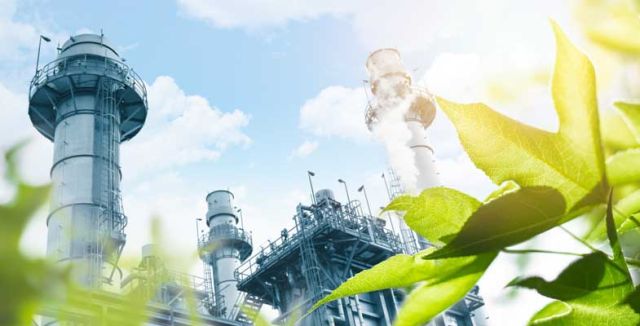
A rendering of a low-carbon power facility. Element Fuels Holdings' complex will transform shale oil into lower carbon fuels, hydrogen and electricity. (Source: Shutterstock)
With a construction start in sight, a complex that will transform shale oil into lower carbon fuels, hydrogen and electricity is moving into the detailed engineering phase following completion of site preparation and preconstruction work.
Texas-based Element Fuels Holdings on June 6 said it has received the permitting it needs to construct and operate the planned facility, which is located on a 240-acre site inside the Port of Brownsville. When the first-of-its-kind complex, billed as a “hydrogen-powered clean fuels refinery and combined-cycle power plant” comes online in 2027, it will be capable of producing more than 160,000 bbl/d of finished gasoline, diesel and jet fuel.
“A permit for a greenfield refinery of this size, scope and functionality has not been granted in the United States since the 1970s,” Element Fuels Co-CEO John Calce said in a statement. “This speaks to the innovative approaches we are taking to address climate and sustainability concerns in cleaner, greener ways that are new to the refinery space.”
McDermott will provide front-end engineering design services, including offsites and utilities, for the project.
Element Fuels told Hart Energy that it will use naphtha reforming to produce hydrogen, which will also be recycled. The process involves use of high-gravity U.S. shale oil—such as the light crude produced in the Permian’s Delaware Basin.
Hydrogen is mostly used today for oil refining, fertilizer production and metals treatment. However, it has potential to decarbonize sectors such as steel, maritime and aviation; power fuel cells; generate electricity; and serve as a transportation fuel. The U.S. and other parts of the world see hydrogen as a key decarbonization tool to reduce global greenhouse gas emissions.
“The refinery, as designed, will reduce CO2 emissions in excess of 500,000 tons per year,” Element Fuels said.
It is designed to “produce and recycle hydrogen using advanced technologies that will generate and deliver significantly cleaner, higher-quality fuels, including much-needed high-octane gasoline and electricity for commercial and consumer consumption.”
The facility is expected to produce enough hydrogen to meet all of the refinery’s needs. Excess hydrogen will be used to generate electricity, which Element Fuels said will be made available to the Electric Reliability Council of Texas (ERCOT). The company anticipates it will generate more than 100 megawatts of excess electricity.
“Element Fuels is not only ushering in the next generation of clean fuels, we’re also proving that, without a doubt, there is a way to produce higher quality, cleaner, higher-octane fuels that significantly advance the energy transition,” Calce said. “This changes everything—for the industry, for consumers, and for the well-being of the planet.”
Construction is expected to begin in first-quarter 2025.
Recommended Reading
Kinder Morgan to Build $1.7B Texas Pipeline to Serve LNG Sector
2025-01-22 - Kinder Morgan said the 216-mile project will originate in Katy, Texas, and move gas volumes to the Gulf Coast’s LNG and industrial corridor beginning in 2027.
Williams’ CEO: Pipeline Permitting Costs Twice as Much as Steel
2025-03-12 - Williams Cos. CEO Alan Armstrong said U.S. states with friendlier permitting polices, including Texas, Louisiana and Wyoming, have a major advantage as AI infrastructure develops.
Entergy, KMI Agree to Supply Golden Pass LNG with NatGas
2025-02-12 - Gas utility company Entergy will tie into Kinder Morgan’s Trident pipeline project to supply LNG terminal Golden Pass LNG.
Intensity Infrastructure Partners Pitches Open Season for Bakken NatGas Egress
2025-02-04 - Analysts note the Bakken Shale’s need for more takeaway capacity as Intensity Infrastructure Partners launches an open season for a potential 126-mile natural gas transport line out of the basin.
FERC Reinstates Permit for Williams’ Mid-Atlantic Project
2025-01-27 - The Federal Energy Regulatory Commission’s latest move allows Williams’ Transco natural gas network to continue operations after a D.C. court shot down the expansion plan.
Comments
Add new comment
This conversation is moderated according to Hart Energy community rules. Please read the rules before joining the discussion. If you’re experiencing any technical problems, please contact our customer care team.






